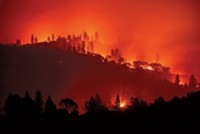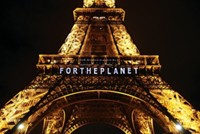Advertisement
Grab your lab coat. Let's get started
Welcome!
Welcome!
Create an account below to get 6 C&EN articles per month, receive newsletters and more - all free.
It seems this is your first time logging in online. Please enter the following information to continue.
As an ACS member you automatically get access to this site. All we need is few more details to create your reading experience.
Not you? Sign in with a different account.
Not you? Sign in with a different account.
ERROR 1
ERROR 1
ERROR 2
ERROR 2
ERROR 2
ERROR 2
ERROR 2
Password and Confirm password must match.
If you have an ACS member number, please enter it here so we can link this account to your membership. (optional)
ERROR 2
ACS values your privacy. By submitting your information, you are gaining access to C&EN and subscribing to our weekly newsletter. We use the information you provide to make your reading experience better, and we will never sell your data to third party members.
Environment
Paris Climate Talks Begin
Far-reaching climate accord may well emerge—but it likely won’t have the desired effect on global temperatures
by Cheryl Hogue
November 30, 2015
| A version of this story appeared in
Volume 93, Issue 47

Undeterred by the deadly terrorist attacks that shook Paris earlier this month, world governments converged on the city today for two weeks of long-anticipated climate change negotiations.

If they strike a deal, as expected, those governments would likely declare the talks a success resulting in the most far-reaching climate accord ever, one that includes commitments by nearly every nation on Earth.
Environmental, human rights, and other activists, however, would point out that the agreement won’t meet the governments’ stated goal of holding average global temperature rise to 2 °C over preindustrial levels by 2100.
They’d both be right.
If the negotiations lead to a pact, nearly 200 countries, large and small, rich and poor, would together take on the responsibility to curb greenhouse gas emissions. That would represent a major shift in diplomacy since nations hammered out the first climate change treaty in 1992. Back then, industrialized nations pledged to curb their emissions while developing countries, which then contributed only small volumes of emissions, got a pass.
Yet according to recent analyses, the pledges made thus far wouldn’t limit average global temperature rise to 2 °C by the end of the century. Instead, they’d set the world on course to a 2.7 °C by 2100. And a paper published last week by researchers in the U.S. and Austria finds that the pledges increase the probability that the world can limit global warming to 2 °C, but whether this can happen will depend on what sort of further emission goals governments agree to take on beyond 2030 (Science 2015, DOI: 10.1126/science.aad5761).
“This agreement won’t solve climate change in one fell swoop,” says Jake Schmidt, international program director for the Natural Resources Defense Council, an environmental group.
Governments hope to revisit the agreement in years to come and make further commitments to cut emissions, still shooting for their 2 °C goal.
Amid security concerns, officials curbed many of the public rallies and events planned around the conference, disappointing those hoping to press the world to aggressively curb climate change.
But the biggest hurdle the Paris talks face is one that has dogged climate change negotiations for years—money. “There is no doubt that financing is the most crucial component yet to be clarified,” says Christiana Figueres, the UN’s top climate change official.
Poorer nations want richer countries to provide financial support so they can adopt cleaner energy technology and adapt to a warmer world. In addition, low-lying island nations whose very existence is threatened by climate change also want funding that will help them recover from damages caused or exacerbated by global warming, such as coastal inundation from sea-level rise.
In a 2009 agreement reached in Copenhagen, industrialized nations promised to pony up $100 billion per year by 2020 in such aid, funneling it through a new UN-overseen organization called the Green Climate Fund. Developing countries, skeptical that financing is forthcoming, want more specifics on when and how that money will flow to them.
“Credible clarity must be provided on the pathway to the $100 billion per year,” Figueres says.
Given the strained state of the world’s economy, industrialized countries have been sparse on details about financing. Whether the financing issue will end up thwarting completion of a deal in Paris remains to be seen.
History Of Climate Accords
The deal that negotiators hope to clinch in Paris would build on the world’s original climate pact, the 1992 UN Framework Convention on Climate Change. Most nations of the world—195 of them—are parties to that 23-year-old treaty, which sets the broad goal of stabilizing greenhouse gas concentrations in the atmosphere “at a level that will prevent dangerous human interference with the climate system.” U.S. President George H. W. Bush was among the world leaders who signed that agreement. The treaty called for the countries that were industrialized at that time to cut their greenhouse gas emissions but set no deadlines or amounts for those reductions.
The international community set timetables and emission levels for industrialized countries in 1997’s Kyoto protocol, which expired in 2012 and was symbolically extended to 2020. The U.S. never became a partner to the Kyoto protocol because of opposition from conservatives, coal interests, and many energy-intensive industries.
In 2009, negotiators meeting in Copenhagen sought to create a climate deal to build on the Kyoto protocol that would include emerging economies with burgeoning emissions, including China and India. Those countries balked, and the talks faltered. After U.S. President Barack Obama intervened at the 11th hour, negotiators settled on a deal that is noteworthy for setting a policy goal for future climate efforts, including the Paris accord: restraining global average rise in temperature to 2 °C over preindustrial levels by 2100.
In addition, rich nations agreed to provide $30 billion per year from 2010 to 2012 to help developing countries decarbonize their economies and adapt to climate change, and that amount is supposed to increase to $100 billion by 2020.
In a significant evolution of climate diplomacy, the Paris agreement is expected to include emission control efforts by all UN nations. Each country is making a written pledge called an intended nationally determined contribution that lays out what it will do to control its domestic emissions. Negotiators hope this so-called bottom-up approach, in which countries set their own emission goals, will be more effective than the top-down Kyoto protocol.
U.S. Policy
In the U.S., a combative Republican Congress is working to halt President Obama’s domestic policies to cut greenhouse gas emissions and snarl his international efforts to seal a climate change deal in Paris.
“The President is attempting to steamroll ahead with an emissions reduction target that he continues to fail to articulate and that the U.S. can neither reasonably achieve nor afford,” says Sen. James Inhofe (R-Okla.), chairman of the Senate Environment & Public Works Committee.
“The President’s far-reaching proposals and international promises will do lasting damage to our nation, all for little to no environmental benefit,” says Rep. Lamar Smith (R-Texas), chairman of the House of Representatives Committee on Science, Space & Technology. “The pledge to the UN is estimated to prevent only a 0.03 °C temperature rise,” he says. “The President’s plan gives control of U.S. energy policy to unelected United Nations officials.”
Inhofe, who says the science over whether climate change is happening is unsettled, is among many lawmakers taking aim at the President’s signature policy for curbing U.S. greenhouse gas emissions, the Clean Power Plan. This Clean Air Act regulation will reduce carbon dioxide releases from fossil-fuel-fired power plants.
Both the Senate and the House are moving legislation that would nullify that rule in hopes of weakening the U.S. negotiation stance in Paris. Doing so would undermine Obama’s pledge for the U.S. to cut its greenhouse gases 26–28% below 2005 levels before 2025.
But David Doniger, climate and clean air program director for the environmental group Natural Resources Defense Council, points out that the Senate, which on Nov. 17 passed the legislation 52-46, is well short of the 67 votes of support needed to override an almost-certain veto. Congress’s inability to override such a veto would signal to the rest of the world that the GOP-controlled legislature does not have the leverage to block the President’s international climate commitments.
Another battle between Congress and Obama involves an issue that UN negotiators will have to settle in Paris. It focuses on whether the agreement that is expected to emerge from Paris is legally binding.
If the Paris accord is considered legally binding, the President must seek input and approval from the Senate. The Republican-controlled Senate would most likely reject the deal. So against the desires of the European Union, the Obama Administration has strongly pushed for the new climate change deal not to be legally binding.
The President is making “a calculated end run around Congress,” says Sen. John Barrasso (R-Wyo.), chairman of the Senate Foreign Relations Subcommittee with jurisdiction over international energy and environmental matters.
The Senate is considering legislation that would deem any agreement emerging from Paris, regardless of whether it is legally binding, to have no effect in the U.S. unless the Senate consents to it.
Others Vow Action
As part of the Paris deal, countries are making pledges to curb their national greenhouse gas emissions. But they’re not alone. Companies and jurisdictions below the national level, including states and cities, are pledging to reduce their emissions too.
The Non-State Actor Zone for Climate Change (NAZCA), a UN organization that grew out of the negotiations leading to Paris, registers commitments to action on climate change by companies, investors such as banks, cities, and subnational regions. Nearly 2,000 companies—including Dow Chemical, Mitsui Chemicals, and Sinopec—and more than 900 cities have signed up so far.
California, which is one of the 10 largest economies in the world, is taking steps to curtain emissions separate from federal efforts. Gov. Jerry Brown (D) earlier this year issued an executive order to reduce California’s greenhouse gas emissions to 40% below 1990 levels by 2030. In October, Brown signed a law to generate half of the state’s electricity from renewable sources by 2030.
Brown helped start a global climate pact for cities, provinces, and states called the Under 2 MOU, which refers to a memorandum of understanding backing a goal of limiting global average temperature rise to less than 2 °C over preindustrial levels by 2100. So far, some 50 jurisdictions in 19 countries across five continents have joined the agreement, pledging to limit their greenhouse gas emissions either to 2 metric tons per capita or to 80–95% below their 1990 levels by 2050. Among the signatories to the deal are the states of New York in the U.S. and North Rhine-Westphalia in Germany and the Dutch province of North Brabant.
In the U.S., chemical, consumer product, and ethanol makers were among 81 companies that signed a pledge in October to curb their greenhouse gas emissions as part of a White House effort.
Follow C&EN’s ongoing coverage of the Paris meeting, the 21st Conference of the Parties to the climate change convention, at http://cenm.ag/cop21.





Join the conversation
Contact the reporter
Submit a Letter to the Editor for publication
Engage with us on Twitter